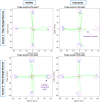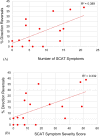Sex-related differences in visuomotor skill recovery following concussion in working-aged adults
- PMID: 35443693
- PMCID: PMC9022305
- DOI: 10.1186/s13102-022-00466-6
Sex-related differences in visuomotor skill recovery following concussion in working-aged adults
Abstract
Background: The ability to perform visually-guided motor tasks requires the transformation of visual information into programmed motor outputs. When the guiding visual information does not align spatially with the motor output, the brain processes rules to integrate somatosensory information into an appropriate motor response. Performance on such rule-based, "cognitive-motor integration" tasks is affected in concussion. Here, we investigate the relationship between visuomotor skill performance, concussion history, and sex during the course of a post-concussion management program.
Methods: Fifteen acutely concussed working-aged adults, 11 adults with a history of concussion, and 17 healthy controls all completed a recovery program over the course of 4 weeks. Prior to, mid-way, and following the program, all participants were tested on their visuomotor skills.
Results: We observed an overall change in visuomotor behaviour in all groups, as participants completed the tasks faster and more accurately. Specifically, we observed significant visuomotor skill improvement between the first and final sessions in participants with a concussion history compared to no-concussion-history controls. Notably, we observed a stronger recovery of these skills in females.
Conclusions: Our findings indicate that (1) concussion impairs visuomotor skill performance, (2) the performance of complex, rule-based tasks showed improvement over the course of a recovery program, and (3) stronger recovery in females suggests sex-related differences in the brain networks controlling skilled performance, and the effect of injury on these networks.
Keywords: Concussion; Eye-hand coordination; Human; Motor control; Psychophysics; Recovery; Sex differences.
© 2022. The Author(s).
Conflict of interest statement
The authors declare that they have no competing interests.
Figures






Similar articles
-
Cognitive-motor integration deficits in young adult athletes following concussion.BMC Sports Sci Med Rehabil. 2015 Oct 19;7:25. doi: 10.1186/s13102-015-0019-4. eCollection 2015. BMC Sports Sci Med Rehabil. 2015. PMID: 26491541 Free PMC article.
-
Sport experience is correlated with complex motor skill recovery in youth following concussion.Eur J Sport Sci. 2019 Oct;19(9):1257-1266. doi: 10.1080/17461391.2019.1584249. Epub 2019 Mar 17. Eur J Sport Sci. 2019. PMID: 30880595
-
White Matter Integrity and Its Relationship to Cognitive-Motor Integration in Females with and without Post-Concussion Syndrome.J Neurotrauma. 2020 Jul 1;37(13):1528-1536. doi: 10.1089/neu.2019.6765. Epub 2020 Mar 18. J Neurotrauma. 2020. PMID: 31928154
-
American Medical Society for Sports Medicine position statement: concussion in sport.Br J Sports Med. 2013 Jan;47(1):15-26. doi: 10.1136/bjsports-2012-091941. Br J Sports Med. 2013. PMID: 23243113 Review.
-
Examination of Reaction Time Deficits Following Concussion: A Systematic Review and Meta-analysis.Sports Med. 2020 Jul;50(7):1341-1359. doi: 10.1007/s40279-020-01281-0. Sports Med. 2020. PMID: 32162242
Cited by
-
Machine learning algorithms for detection of visuomotor neural control differences in individuals with PASC and ME.Front Hum Neurosci. 2024 Apr 4;18:1359162. doi: 10.3389/fnhum.2024.1359162. eCollection 2024. Front Hum Neurosci. 2024. PMID: 38638805 Free PMC article.
References
Grants and funding
LinkOut - more resources
Full Text Sources

